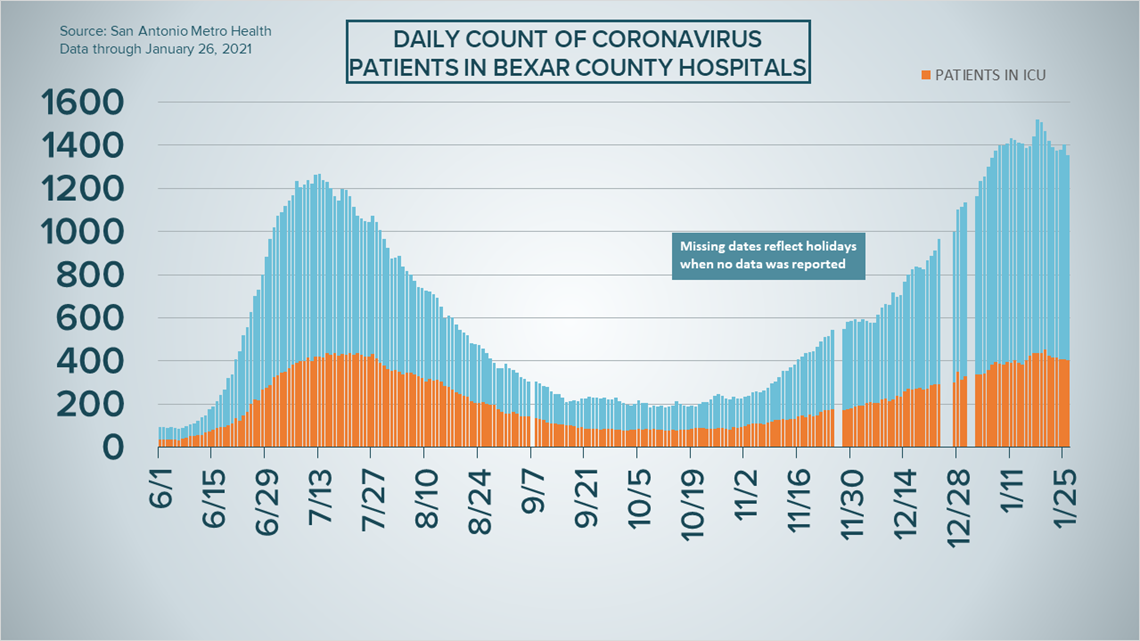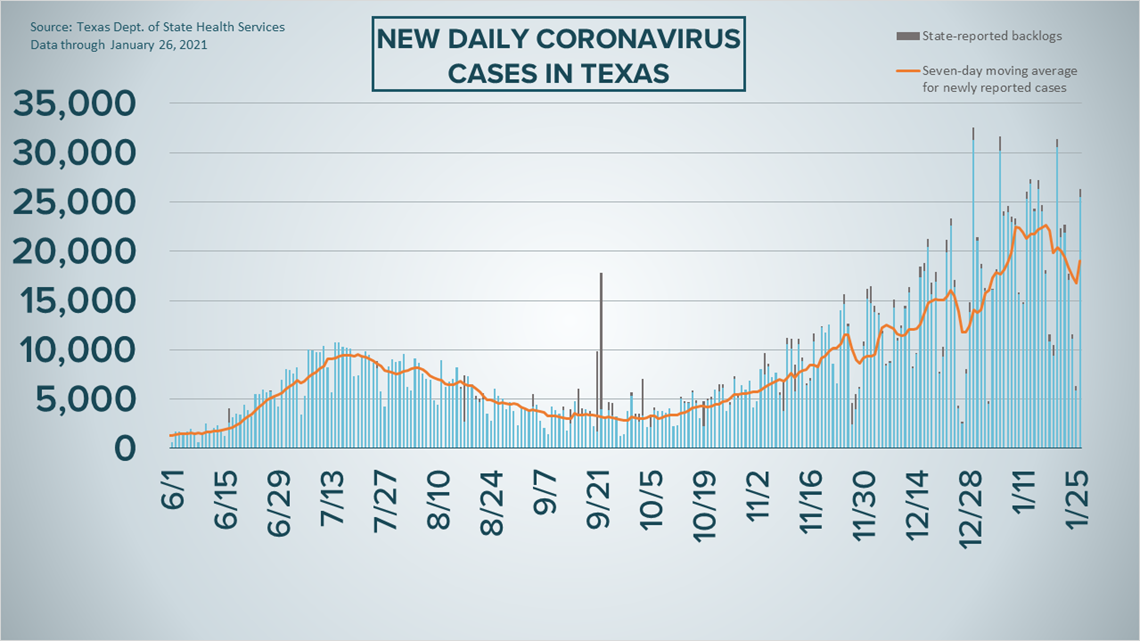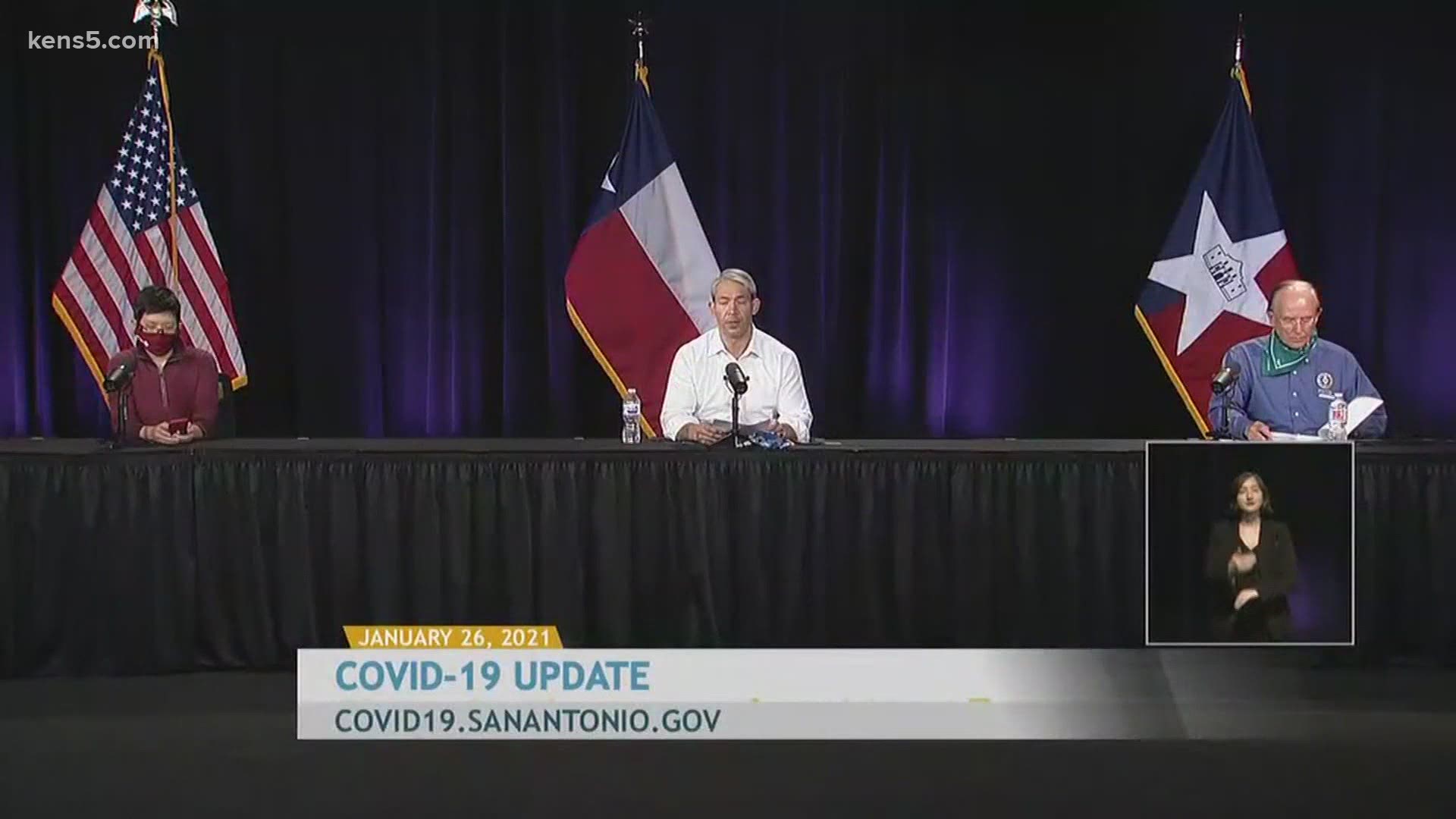SAN ANTONIO — We're tracking the latest numbers from the coronavirus pandemic in San Antonio and across Texas. Here are the latest numbers reported by Bexar and surrounding counties:
- Bexar County: On Tuesday, 821 new cases were reported, bringing the total number of cases to 162,929. Eighteen new deaths were also reported, raising the local death toll to 1,998.
- Hays County: On Tuesday, officials reported 158 new cases in the county and two additional COVID-related fatalities. As of Tuesday, there are a total of 14,640 lab-confirmed local cases, while the death toll rose to 177. Officials estimate 11,863 residents have recovered, while 2,600 are still ill with the virus.
- Comal County: On Tuesday, officials reported 114 new cases and three additional COVID-related fatalities. There are a total of 7,773 cases, including 4,267 confirmed and 3,494 probable cases, while 242 county residents have died due to COVID-19 complications. The county estimates 6,818 residents have recovered, while 713 are still ill with the virus.
More county case information is available through the Texas Department of Health Services COVID-19 dashboard.
How Bexar County is trending
We've tracked how many coronavirus cases have been confirmed in Bexar County from the time officials began reporting cases in March 2020. The graphic below shows the number of cases since June and charts those daily case numbers along a 7-day moving average to provide a more accurate picture of the overall coronavirus case curve in our area and the direction we're trending amid the pandemic.
On Tuesday, Mayor Ron Nirenberg reported an additional 821 new coronavirus cases in Bexar County, a steep drop from the tally of 2,082 reported Monday. In all, 162,929 Bexar County residents have been diagnosed with the virus, while the comparatively lower total has lowered the seven-day moving average to 1,497; just over a week ago, the seven-day moving average had peaked at 2,251.
Nirenberg also reported 18 new coronavirus-related deaths, for a total of 1,998 in the county since the pandemic began.


Meanwhile, there were 49 fewer coronavirus hospitalizations on Tuesday compared to Monday, for a concurrent total of 1,353. That's the lowest number of local hospitalized patients in nearly three weeks.


Coronavirus in Texas
The total number of novel coronavirus cases in the state since the pandemic began grew by 26,274 on Tuesday, according to the Texas Department of State Health Services—a marked figure compared to the 6,000+ new cases reported Monday. That total includes 21,813 new confirmed cases, 3,651 new probable cases, and 810 cases attributed to backlogs not previously reported in the state's total (more details can be found at the top of this page).
Tuesday's figures bring the total number of Texans diagnosed with COVID-19 to more than 2.273 million.


Meanwhile, state health authorities also reported 307 new virus-related deaths. At least 34,701 Texans have died from COVID-19 complications.
After a week of steadily declining hospitalization totals in Texas hospitals, the number of COVID-19 patients receiving treatment for their symptoms increased for the first time since Jan. 18 on Tuesday, by 66. The concurrent total stands at 12,851.
The state estimates that about 1.845 million Texans have recovered, while 376,862 Texans remain ill with COVID-19.
The latest update from the Texas Education Agency showed that there have been at least 128,973 cumulative cases among staff and students across the state through January 17. That number comprises 81,118 positive student cases and 47,885 staff cases. More information can be found here.
The TEA releases new data on school cases on Fridays.
Latest Coronavirus Headlines
- Global confirmed coronavirus cases now over 100 million
- Could more vaccination sites in SA start scheduling appointments more than a week in advance?
- Spurs game against Pelicans postponed due to coronavirus contact tracing
- The COVID-19 vaccine and pregnancy
- Coronavirus and your skin: tips for taking care of your hands
- Moderna says COVID-19 vaccine protects against virus variant in UK, South Africa
- Job losses from coronavirus 4 times as bad as '09 financial crisis, UN Report says
- US passes 25 million confirmed cases of COVID-19
Coronavirus symptoms
The symptoms of coronavirus can be similar to the flu or a bad cold. Symptoms include fever or chills, cough, shortness of breath or difficulty breathing, fatigue, muscle or body aches, headache, new loss of taste or smell sore throat, congestion or runny nose, nausea or vomiting, and diarrhea, according to the Centers for Disease Control.
Most healthy people will have mild symptoms. A study of more than 72,000 patients by the Centers for Disease Control in China showed 80 percent of the cases there were mild.
But infections can cause pneumonia, severe acute respiratory syndrome, kidney failure, and even death, according to the World Health Organization. Older people with underlying health conditions are most at risk.
Experts determined there was consistent evidence these conditions increase a person's risk, regardless of age:
- Chronic kidney disease
- COPD (chronic obstructive pulmonary disease)
- Obesity (BMI of 30 or higher)
- Immunocompromised state (weakened immune system) from solid organ transplant
- Serious heart conditions, such as heart failure, coronary artery disease, or cardiomyopathies
- Sickle cell disease
- Type 2 diabetes
The CDC believes symptoms may appear anywhere from two to 14 days after being exposed.
Human coronaviruses are usually spread...
- Between people who are in close contact with one another (within about 6 feet).
- Through respiratory droplets produced when an infected person coughs, sneezes or talks. These droplets can land in the mouths or noses of people who are nearby or possibly be inhaled into the lungs.
- Some recent studies have suggested that COVID-19 may be spread by people who are not showing symptoms.
Help stop the spread of coronavirus
- Stay home when you are sick.
- Eat and sleep separately from your family members
- Use different utensils and dishes
- Cover your cough or sneeze with your arm, not your hand.
- If you use a tissue, throw it in the trash.
Find a Testing Location
City officials recommend getting a COVID-19 test if you experience fever or chills, cough, shortness of breath or difficulty breathing, fatigue, muscle or body aches, headache, new loss of taste or smell, sore throat, congestion or runny nose, nausea or vomiting, or diarrhea.
San Antonio operates several no-cost testing locations, including two walk-up locations open Monday-Sunday from 10 a.m. until 2 p.m.:
Cuellar Community Center
5626 San Fernando St.
San Antonio, TX 78237
Ramirez Community Center
1011 Gillette Blvd.
San Antonio, TX 78224
Additionally, Freeman Coliseum offers drive-through no-cost testing from Monday through Sunday between 9 a.m. and 4 p.m. An appointment is required and can be made either online or by calling (833) 213-0643.
Here's a Testing Sites Locator to help you find the testing location closest to you in San Antonio.

